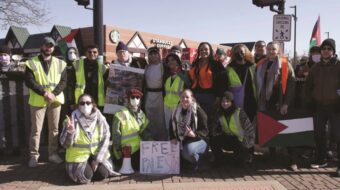In an attempt to shore up alliances and gain support for stepped-up military operations in Iraq and Afghanistan, the Bush administration dispatched Vice President Dick Cheney to meet with heads of state in Japan, Australia, Pakistan and Afghanistan.
Cheney’s visit to Australia Feb. 22-25 sparked protests against right-wing Prime Minister John Howard’s backing for the Bush administration’s Iraq war. According to polls, two-thirds of Australian voters want Howard to set a date for the removal of the 1,450 Australian troops in Iraq or bring them home immediately. Polls indicate that Howard, in power for 11 years, is trailing Labor Party leader Kevin Rudd by 8 percent in the build-up to elections later this year. Ignoring the polls, Cheney commended Australians who had “never wavered in the war on terror.”
Rudd, who met with Cheney, has vowed to bring home 500 troops from Iraq right away if he wins. He had told reporters, “This war in Iraq represents the single greatest failure of Australian national security policy since Vietnam.”
A Reuters commentator said Howard is “enduring a perfect storm” on Iraq and on Australia’s alliance with the U.S. The Sydney Morning Herald used the headline “Out of Step!” to introduce a recent editorial denouncing Australian support for the Iraq war.
Over 500 demonstrators came out on Feb. 22 before Cheney’s arrival and again the following day demanding the return of Australian troops. They called for Guantanamo prisoner David Hicks, an Australian citizen, to be tried or released.
The police made news. Over 1,200 of them of them massed in Sydney’s streets, and, according to a legal observer with the Sydney Stop the War Coalition, carried out violent reprisals against demonstrators, reminiscent of Vietnam-era police actions. He was “disturbed to see the police crack down on a peaceful protest … When protesters decided to march, they were beaten, shoved, punched and strangled by officers.”
The White House had induced the New South Wales legislature to authorize U.S. security units accompanying Cheney to carry arms. Critics called the “hasty change” to accommodate Cheney a dangerous precedent.
While boosting U.S. militarism during his Australia visit, Cheney criticized what he characterized as a military build-up by China. In a flash of understatement, a BBC reporter in Australia called his remarks “significant because Mr. Cheney often delivers the authentic voice of the White House.”
Cheney’s biggest impact on ordinary Australians may have been the major traffic snarls he created over several days, when his 32-car mile-long cavalcade was given priority on Sydney’s roads. Even the Sydney Harbor bridge was closed, making this inconvenience a much bigger talking point among residents than Cheney’s fear-mongering.
Cheney’s arrival in Japan on Feb. 19 followed Defense Minister Fumio Kyuma’s declaration that the Iraq war had been a mistake, a notion supported by 57 percent of Japanese adults. Cheney shunned Kyuma, meeting instead with senior military officers. He did meet with Foreign Minister Taro Aso who, speaking to reporters, had characterized U.S. occupation strategies in Iraq as “immature.”
Among the Japanese public significant opposition persists to constitutional changes undertaken to promote the U.S.-Japanese military alliance.
Addressing Japanese leaders, including Prime Minister Shinzo Abe, on the U.S. aircraft carrier Kitty Hawk, Cheney praised “Japan’s own rising sense of leadership and confidence internationally” manifested by sending 500 troops to Iraq.
Cheney’s low-profile Feb. 26 visit to Pakistan coincided with a meeting on Middle Eastern affairs in Islamabad joined by foreign ministers of seven Islamic countries.
Apparently Cheney did not take part in those proceedings. His talks with President Pervez Musharraf, and with Afghan President Hamid Karzai the next day, reportedly covered the increased Taliban activity in Pakistani areas close to the Afghan border and the Taliban’s anticipated spring offensive.
The Bush administration views Pakistan as a key military ally. But administration officials fear that Pakistan’s withdrawal from the frontier province of Waziristan last fall could make it easier for Taliban and al-Qaida forces to attack across the border.
An explosion ignited by a suicide bomber outside the U.S. Bagram Air Base in Kabul, while Cheney was there, killed up to 20 persons and wounded 20.
The U.S. recently sent 3,200 additional troops to Afghanistan and is campaigning for increased NATO support. Cheney received a promise Feb. 22 from Prime Minister Howard to double Australian troops there. They now total 500.
atwhit @ megalink.net

MOST POPULAR TODAY

High Court essentially bans demonstrations, freedom of assembly in Deep South

Zionist organizations leading campaign to stop ceasefire resolutions in D.C. area

U.S. imperialism’s ‘ironclad’ support for Israel increases fascist danger at home


UN warns that Israel is still blocking humanitarian aid to Gaza





Comments